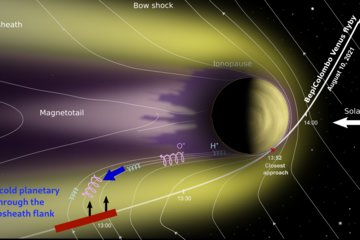All genres
61.
Journal Article
Models and data analysis tools for the Solar Orbiter mission. Astronomy and Astrophysics 642, A2 (2020)
62.
Journal Article
The Solar Orbiter Science Activity Plan: translating solar and heliospheric physics questions into action. Astronomy and Astrophysics 642, A3 (2020)
63.
Journal Article
Spectroscopy of Very Hot Plasma in Non-flaring Parts of a Solar Limb Active Region: Spatial and Temporal Properties. Astrophysical Journal 846 (1), 25 (2017)
64.
Journal Article
Propagating disturbances along fan-like coronal loops in an active region. Research in Astronomy and Astrophysics 15 (11), pp. 1832 - 1842 (2015)
65.
Journal Article
Solar extreme ultraviolet variability of the quiet Sun. Astronomy and Astrophysics 581 (A51), A51 (2015)
66.
Journal Article
Characteristics of polar coronal hole jets. Astronomy and Astrophysics 561, A104 (2014)
67.
Journal Article
Scattered Lyman-alpha radiation of comet 2012/S1 (ISON) observed by SUMER/SOHO. Astronomy and Astrophysics 567, L1 (2014)
68.
Journal Article
In‐flight UV and polarized‐VL radiometric calibrations of the solar orbiter/METIS imaging coronagraph. Proceedings of the SPIE 9144, 914409 (2014)
69.
Journal Article
Hardware and software architecture on board solar orbiter/METIS: an update. Proceedings of the SPIE 9144, 91443F (2014)
70.
Journal Article
SPICE EUV Spectrometer for the Solar Orbiter Mission. Proceedings of the SPIE 8862, p. 0F1 ‐ 0F15 (2013)
71.
Journal Article
Quiet Sun Explosive Events: Jets, Splashes, and Eruptions. Solar Physics 282, pp. 453 - 469 (2013)
72.
Journal Article
Multi Element Telescope for Imaging and Spectroscopy (METIS) coronagraph for the Solar Orbiter mission. Proceedings of the SPIE 8443, 844309-844309-12 (2012)
73.
Journal Article
Doppler shift of hot coronal lines in a moss area of an active region. Astronomy and Astrophysics 548, A115 (2012)
74.
Journal Article
Spectroscopic observations of propagating disturbances in a polar coronal hole: evidence of slow magneto-acoustic waves. Astronomy and Astrophysics 546, A93 (2012)
75.
Journal Article
LEMUR: Large European module for solar Ultraviolet Research. European contribution to JAXA's Solar-C mission. Experimental Astronomy 34 (2), pp. 273 - 309 (2012)
76.
Journal Article
Spectroscopic Observations of Fe XVIII in Solar Active Regions. Astrophysical Journal 754, L40 (2012)
77.
Journal Article
The quiet Sun average Doppler shift of coronal lines up to 2 MK. Astronomy and Astrophysics 534, A90 (2011)
78.
Journal Article
Evolution of microflares associated with bright points in coronal holes and in quiet regions. Astronomy and Astrophysics 529, A21 (2011)
79.
Journal Article
LEMUR (Large European Module for solar Ultraviolet Research): a VUV imaging spectrograph for the JAXA Solar-C Mission. Proceedings of the SPIE 8148, p. 81480I-81480I-13 (2011)
80.
Journal Article
Solar magnetism eXplorer (SolmeX). Experimental Astronomy 33, pp. 271 - 303 (2011)











